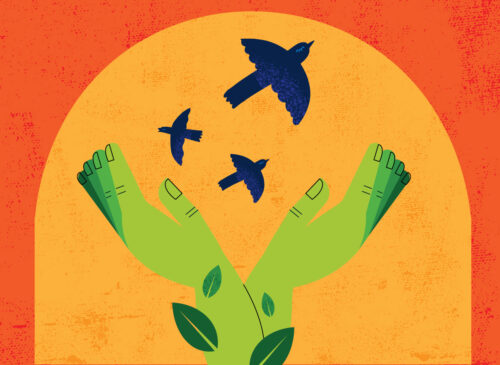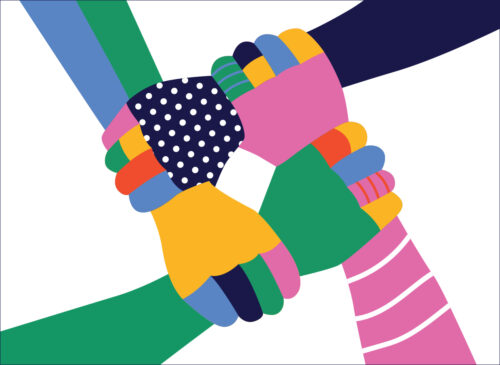As academic convenor of the 2023 Congress of the Humanities and Social Sciences, Andrea A. Davis worked with a diverse community to shift the form, content, and vision of the longstanding conference. She asks: where will these interventions take us?

I received the invitation to assume the role of Academic Convenor of the 2023 Congress of the Humanities and Social Sciences in the fall of 2021, after having just completed a year as inaugural special advisor on anti-Black racism strategies in the Faculty of Liberal Arts & Professional Studies at York University. Both the invitation to convene Congress and the advisory role occurred within the context of global social protests following the police murder of George Floyd in spring 2020. George Floyd’s death took place 186 years after the abolition of chattel slavery in Canada in 1834, 153 years after Confederation united the so-called white “founding nations” and excluded Indigenous peoples from the formation of the nation-state in 1867, and almost 200 years after the establishment of McGill College in 1821—Canada’s first university. It, therefore, took Canadian society and its educational institutions more than a century and a half to begin, in some earnestness, to look for ways to correct their history of white supremacy and problem of under-representation, trying to land on the right side of history.
Recognizing Black and Indigenous Humanity
Certainly, for Black people, this slow trajectory of change is stunning, but also unremarkable. It is unremarkable because, as professor and author Rinaldo Walcott suggests in the 2021 book The Long Emancipation, Black people (whether we are descendants of the enslaved or experienced a different kind of conquest as indigenous continental Africans) “are still in the time of emancipation,’’ waiting for a freedom that is yet to come; a freedom “which is extra-emancipation or beyond the logic of emancipation.” The freedom that would allow Black people to exist as they would simply want to be is beyond the logic of emancipation because even the white abolitionists who fought to dismantle the system of slavery and many of the liberal white progressive professors in university departments and classrooms did not, and still cannot, imagine a Black subject that is their equal with the same capacity for thought, ideas, and sentience. In her critique of humanism, Sylvia Wynter argues that the construction of the category of “Man” was made possible only through the negation of different Others, including Black and Indigenous peoples, poor people, women, and refugees. That the category “Black” routinely assumes all these categories of exclusion (someone who is differentially raced, poor, jobless, and globally homeless) makes clear the extent to which Black people have been and continue to be imagined as outside the normative conception of a humanity deserving of justice, protection, and care.
Certainly, for Black people, this slow trajectory of change is stunning, but also unremarkable.
If the murder of George Floyd and the murder of Indigenous women and girls have been the catalyst for this belated reckoning in Canadian universities and the wider society, then we must ask ourselves why it always takes Indigenous and Black death and abjection to produce change. The fact that Indigenous and Black peoples are entitled to life, freedom, and a sense of humanity doesn’t seem to be enough to move the arc of the moral compass of our societies in any meaningful way. At the end of the day, Black people can only be understood through what Saidiya Hartman, in her 1997 book Scenes of Subjection: Terror, Slavery, and Self-Making in Nineteenth-Century America, calls “the spectacular character of Black suffering,” through exceptional violence, and through Black fungibility. According to Hartman, white abolitionists could only understand Black suffering by resubstituting themselves as the abused; by replacing the imagined Black body with a white body; by recasting that Black body as their own. “Black sentience,” Hartman says, is “incommensurable and unimaginable” in its own right; “the very ease of possessing the abased and enslaved body…elide[s] an understanding and acknowledgement of the slave’s pain.” In the same way, it was the spectacular death of George Floyd, an unarmed Black man—viewed over and over again—that made possible a certain kind of substitution that then released a sense of horror and empathy that galvanized the protests, that led to the changes we are seeing in universities. It was by visually and vicariously standing in the place of Black suffering that Canadians were collectively moved.
Learning to think and act oppositionally
How do we make it possible to recognize the everyday hurt Indigenous and Black students experience in classrooms, from university instructors who assume they are not smart enough and must therefore be monitored and surveilled, or from students who resent their interventions? How do we recognize the everyday violence against brown students who are stereotyped or dismissed as non-speakers of English and non-Christians? How do we make knowable the pain racialized faculty, students, and staff carry across their campuses, into their classrooms, onto buses and subways and city streets, knowing that one moment of misrecognition could result in another catastrophe? I am an immigrant to this country, but most of my students are not, and the country in which they were born or have lived since they were children has not loved them or desired to protect them. And they have experienced that violence of national abandonment most consistently in the educational system: first in kindergarten and elementary and high school, and now in university systems premised on white supremacy. As James Baldwin notes in his 1965 speech at the Cambridge Union, “it comes as a great shock to discover the country which is your birthplace, and to which you owe your life and your identity, has not in its whole system of reality evolved any place for you.”
As a Black woman who has spent her career doing the work of diversifying the academy long before “equity, diversity, and inclusion” became a catchphrase, how do I resist having those efforts co-opted while continuing to serve racialized students and faculty? If we know that Canadian universities are not exempted from, but deeply implicated in histories of anti-Indigenous and anti-Black racism and white supremacy, what does that knowledge require of us? If anti-Blackness, as Christina Sharpe argues in the book In the Wake: on Blackness and Being, is the ground we walk on, how does this knowledge demand that we read, think, and learn against the grain of our own disappearance? How might we think oppositionally, against the grain of racism, classism and sexism, and the institutions and discourses that support and normalize these forms of violence, including universities?
How might we think oppositionally, against the grain of racism, classism and sexism, and the institutions and discourses that support and normalize these forms of violence, including universities?
Reimagining academic engagement at Congress
These questions animated webinars and teach-ins throughout 2020 and 2021 and were at the forefront of my mind when I stepped into the role as academic convenor of Congress. Several scholarly associations, in fact, had previously withdrawn their participation in Congress in protest of anti-Black racism. It was clear that something fundamental needed to shift, both in the way we understand and do research in the humanities and social sciences and in the way we conceptualize academic conferences as elite, often inaccessible spaces of knowledge production and exchange. I understood that it was important first to rebuild trust, and I had to be sure I could bring others along with me. Before even accepting the role, I reached out to Black scholars outside of York to see what the possibilities were for collaboration and genuine change. Having established that participation, the work at York could begin in earnest. With a scholarly planning committee made up of Indigenous, Black, and other racialized colleagues and graduate researchers, women and co-resistors, we set out do this work, undertaking broad consultation with the university community and local community partners and high schools in the surrounding Jane and Finch neighbourhood. While incorporating university priorities, the scholarly planning committee sought from the beginning to make this a Congress that was animated from the margins—a Congress driven from below.
I understood that it was important first to rebuild trust, and I had to be sure I could bring others along with me.
Guided by the Congress theme, “Reckonings and Re-Imaginings,” we sought to shift the culture of Congress in ways that moved our desire from merely an aspiration on paper to one that could be felt in tangible ways. We needed to provide the space for meaningful engagement with the difficult issues raised by the theme, while leaving room for delegates to self-reflect and grow. That demanded a sense of community that could connect attendees across scholarly associations, as well as places of safety to which Indigenous, Black, and other racialized scholars could retreat if they needed to. By centring the knowledges of Indigenous and Black communities, and the United Nations’ sustainable development goals (SDGs) embedded in York University’s Academic Plan, we hoped to make visible the ways in which Black and Indigenous thought allowed us to think critically about global challenges of sustainability, forced migrations, racial inequities, colonialism, and overconsumption while also allowing possibilities for thinking otherwise. Emphasizing art, media, and design as important modes of academic inquiry and embodied memory deepened the sense of community and helped to signal Congress 2023 as a multi-modal, interdisciplinary, and deeply generative space.
For the first time in the history of Congress, all speakers and moderators at the Big Thinking lecture series were Indigenous or Black. Moving away from the idea of a singular, authoritative academic thinking and working in isolation, we brought Indigenous and Black thinkers—including artists and public intellectuals—into conversation with each other in panels, and as moderators and respondents. Rather than simply thinking from the space of discrete disciplines, these thinkers met each other across their histories and lived experiences and from their own spheres of influence to think deeply and honestly about the crisis of our times, the precarity of Black and Indigenous life, and a planet under siege. There was no denying the power of these offerings. From filmmaker Alanis Obamsawin’s invocation of love, to Michaëlle Jean’s haunting memories of Haiti, and the various reflections on decolonial, anti-racism, queer, two-spirit, and critical disability perspectives, each meeting was rich and profoundly moving. In the midst of rigorous academic inquiry, there was poetry and song. From the literal sharing of smudging and other healing practices backstage to the figurative holding of hands and hearts on stage, this was an academic conference I had certainly never experienced before. The fact that most scholarly associations leaned into and amplified the theme in their own conferences demonstrated that centring Indigenous and Black knowledges in humanities and social science research is not only possible, but necessary, and that more and more today’s researchers and students are demanding this recognition and accountability.
Congress 2023 also sought to offer concrete responses to the crisis facing our planet. Designated as Canada’s largest Fair Trade event and the first hybrid Congress, it modeled possibilities for sustainability for future academic events. This included a significant reduction in print material and the use of Swag Stages featuring music, dance, and theatrical performances in place of branded promotional items. Delegates could take the memory of these performances with them rather than items most of them would not use. A zero-waste approach was also taken to the Big Thinking lectures, President’s Receptions, and Volunteer Recognition event after Congress. Hosting a hybrid Congress, while extraordinarily challenging, helped to mitigate stresses to the planet caused by air travel. This also made the event more accessible to those unable to travel because of their health, or the difficulty of acquiring visas because they live and work in the Global South.
What will we carry forward?
As we enter a new academic term, the question becomes: where will these interventions take us? It’s been more than three months since Congress ended. How quickly will we rush to forget? As humanities and social science scholars, have we established a benchmark from which we cannot retreat or do we silently go back to “business as usual”? Was Congress 2023 a box we checked? Was it something to reflect on with some degree of pride rather than a reminder of how far we have yet to go, of how much work is yet to be done? Those of us who have been doing forms of this work for a long time know that the attention span of universities can be as short as the attention span of governments and wider publics in search of the next newsworthy thing. But, as George Floyd reminded us, the work some of us do is never just about research. It’s often about life and death, and we know the work to save lives must continue.
As humanities and social science scholars, have we established a benchmark from which we cannot retreat or do we silently go back to “business as usual”?










